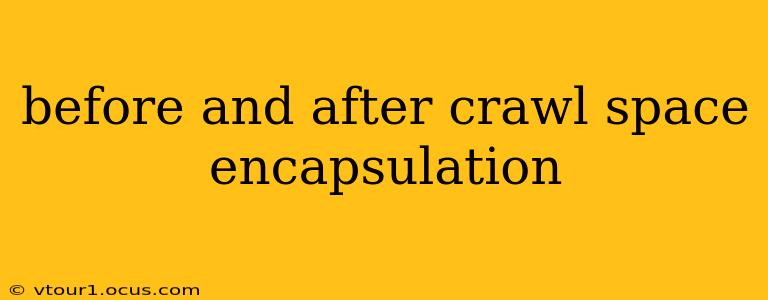Crawl space encapsulation is a significant home improvement project that can dramatically improve your home's comfort, energy efficiency, and overall health. Understanding the differences between a crawl space before and after encapsulation is crucial for homeowners considering this investment. This guide will explore the transformation, addressing common questions and concerns.
What is Crawl Space Encapsulation?
Crawl space encapsulation involves sealing off your home's crawl space from the outside environment. This is achieved by lining the walls and ground with a waterproof vapor barrier, often polyethylene plastic sheeting, and sealing all gaps and cracks. The goal is to create a dry, conditioned space that prevents moisture, pests, and allergens from entering your living areas.
Before Crawl Space Encapsulation: Common Issues
Before encapsulation, many crawl spaces suffer from a variety of problems. These issues can significantly impact your home's health and energy efficiency:
- High Humidity and Moisture: Damp earth and poor ventilation lead to high humidity levels, fostering mold, mildew, and wood rot. This can cause musty odors, structural damage, and respiratory problems for occupants.
- Pest Infestations: Open crawl spaces are havens for insects, rodents, and other pests that can easily access your home.
- Poor Air Quality: Mold spores, dust mites, and other allergens accumulate in damp crawl spaces, negatively affecting indoor air quality.
- Energy Loss: Uninsulated and unsealed crawl spaces allow significant heat loss in winter and heat gain in summer, increasing energy bills.
- Structural Damage: Moisture-related issues can weaken the structural integrity of your home's foundation and framing.
After Crawl Space Encapsulation: The Transformation
The changes after crawl space encapsulation are significant and far-reaching:
- Dry and Clean Crawl Space: The vapor barrier effectively prevents moisture from entering the crawl space, resulting in a noticeably drier environment. This significantly reduces the risk of mold and mildew growth.
- Improved Indoor Air Quality: By controlling moisture and preventing allergen entry, encapsulated crawl spaces contribute to cleaner and healthier indoor air.
- Reduced Pest Activity: Sealing the crawl space effectively eliminates access points for pests, minimizing infestations.
- Increased Energy Efficiency: Proper insulation and sealing minimize heat transfer, reducing energy consumption and lowering utility bills.
- Enhanced Home Value: Crawl space encapsulation is a valuable home improvement that increases your home's value and marketability.
- Improved Structural Integrity: A dry crawl space prevents moisture-related damage, enhancing the structural integrity of your home's foundation and framing.
What are the Benefits of Encapsulating a Crawl Space?
The benefits extend beyond just a cleaner crawl space. Encapsulation offers a range of advantages, including:
- Healthier Living Environment: Improved air quality contributes to a healthier living environment, especially beneficial for those with allergies or respiratory sensitivities.
- Cost Savings: Reduced energy bills and fewer pest control expenses lead to significant cost savings over time.
- Increased Home Comfort: A dry and well-insulated crawl space contributes to a more comfortable living environment year-round.
- Protection of Home's Structure: Prevention of moisture-related damage safeguards the long-term structural integrity of your home.
How Much Does Crawl Space Encapsulation Cost?
The cost of crawl space encapsulation varies depending on several factors, including the size of the crawl space, the complexity of the project, and regional labor costs. It's essential to obtain multiple quotes from reputable contractors to compare prices and services.
What is the Lifespan of Crawl Space Encapsulation?
With proper installation and maintenance, a well-encapsulated crawl space can last for many years, typically 20-30 years or longer. Regular inspections and repairs of any damaged areas are crucial for maintaining its effectiveness.
How Do I Choose a Contractor for Crawl Space Encapsulation?
Choosing the right contractor is vital for a successful encapsulation project. Look for contractors with experience, positive reviews, and appropriate licensing and insurance. Don't hesitate to ask for references and examine their past projects.
Can I DIY Crawl Space Encapsulation?
While some homeowners attempt DIY encapsulation, it's generally recommended to hire a professional. Proper installation requires specialized knowledge and equipment to ensure the project's effectiveness and longevity. Improper installation can lead to wasted money and ongoing problems.
By carefully considering the before and after aspects of crawl space encapsulation, homeowners can make an informed decision about this significant home improvement project. Remember, a well-encapsulated crawl space offers numerous benefits that enhance your home's value, comfort, and health for years to come.
